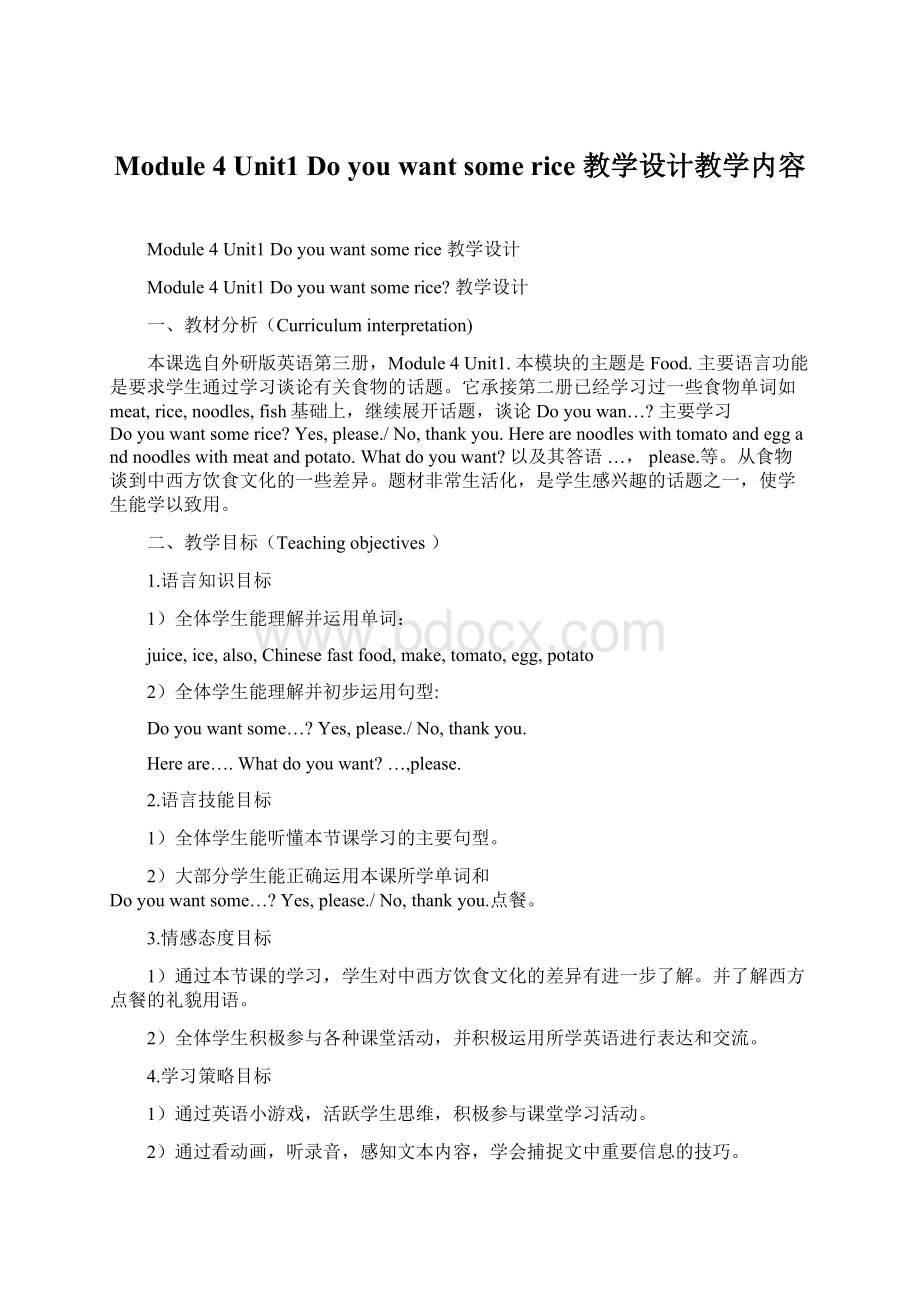Module 4 Unit1 Do you want some rice 教学设计教学内容.docx
《Module 4 Unit1 Do you want some rice 教学设计教学内容.docx》由会员分享,可在线阅读,更多相关《Module 4 Unit1 Do you want some rice 教学设计教学内容.docx(5页珍藏版)》请在冰豆网上搜索。

Module4Unit1Doyouwantsomerice教学设计教学内容
Module4Unit1Doyouwantsomerice教学设计
Module 4 Unit1Do you want some rice?
教学设计
一、教材分析(Curriculum interpretation)
本课选自外研版英语第三册,Module 4 Unit1. 本模块的主题是Food. 主要语言功能是要求学生通过学习谈论有关食物的话题。
它承接第二册已经学习过一些食物单词如meat, rice, noodles, fish基础上,继续展开话题,谈论Do you wan…?
主要学习Do you want some rice?
Yes, please./ No, thank you. Here are noodles with tomato and egg and noodles with meat and potato. What do you want?
以及其答语 …, please.等。
从食物谈到中西方饮食文化的一些差异。
题材非常生活化,是学生感兴趣的话题之一,使学生能学以致用。
二、教学目标(Teaching objectives )
1.语言知识目标
1)全体学生能理解并运用单词:
juice, ice, also, Chinese fast food, make, tomato, egg, potato
2)全体学生能理解并初步运用句型:
Do you want some…?
Yes, please./ No, thank you.
Here are…. What do you want?
…,please.
2.语言技能目标
1)全体学生能听懂本节课学习的主要句型。
2)大部分学生能正确运用本课所学单词和Do you want some…?
Yes, please./ No, thank you.点餐。
3.情感态度目标
1)通过本节课的学习,学生对中西方饮食文化的差异有进一步了解。
并了解西方点餐的礼貌用语。
2)全体学生积极参与各种课堂活动,并积极运用所学英语进行表达和交流。
4.学习策略目标
1)通过英语小游戏,活跃学生思维,积极参与课堂学习活动。
2)通过看动画,听录音,感知文本内容,学会捕捉文中重要信息的技巧。
3)通过角色表演小活动,增强对所学英语的体验,培养正确运用所学英语解决实际问题的能力。
4)通过小组合作,积极与他人合作,相互帮助,共同完成学习任务。
三、教学重、难点分析(Important and difficult points)
1. 教学重点(Important / Key points)
单词:
Juice, ice, also, Chinese fast food, make, tomato, egg, potato
句型:
Do you want some…?
Yes, please. / No, thank you.的运用。
2. 教学难点(Difficult points)
1)Do you want some…?
Yes, please. /No, thank you.
2)____with ____的用法
3) 用Here are… and …来介绍几种食物
四、教学策略(Teaching strategies)
1. 任务型教学法:
让学生带着问题看动画。
2. 以旧带新教学法:
运用学生已有知识经验,在自由交流中自然导入。
3. 情境创设法:
创设合理的情境,进行语言操练。
五、教学准备(Teaching Preparation):
多媒体课件、单词卡片、食物图片、餐盘等。
六、教学过程(Teaching Process)
(一) Warming up
1.Greetings:
Hello, boys and girl. Let’s begin our class with a chant, OK?
2. Say the chant:
Noodles and rice
Are very, very nice
Juice with ice,
is also very nice
3.Elicit “juice with ice” from the chant.
利用rice with fish noodles with meat练一下with 用法
【设计意图】利用学生学过的chant,既活跃了课堂气氛,又复习了本课将要用到的食物单词,直接引出新单词juice with ice,并利用已学过的食物单词让学生更好的理解…with…的用法,并为课文中知识点noodles with tomato and egg , noodles with meat and potato做准备。
(二)Pres-teaching
1. Elicit the word “food”
T:
noodles and rice, ginger and spice, juice with ice. They are all “food”. What’s the meaning of food?
单词卡片出示并学习。
Pay attention to the pronunciation “oo”
2. Brainstorm:
What food do you know?
3. Compare Chinese fast food and English fast food
T:
Now, look here. They are fast food. What‘s the meaning of fast food?
Hamburger, chips, sandwiches are English fast food. Rice and noodles are Chinese fast food.(引出Chinese fast food, 通过食物的对比让孩子对西式快餐,中式快餐有直观的了解,从而加深对中西方文化差异的认识)
【设计意图】引出food,并用头脑风暴调动学生关于食物的知识储备,为教学的深入做准备。
在正文开始前解决Chinese fast food,循序渐进,把难点分散开来。
(三) Presentation
1. Watch the video and answer the question:
“What food does Amy want?
”
【设计意图】本环节主要是帮助学生理解对话大意,呈现重点知识。
学生带着问题观看动画视频,寻找答案的过程就是理解课文和呈现重点的过程。
2. Learn the new target sentences:
Do you want some…?
Yes, please. /No, thank you.
T:
Does Amy want some rice?
Get the answer:
No, thank you. (板书)
T:
Does Amy want some noodles?
Get the answer:
Yes, please.(板书)
T:
How does Daming ask?
Get the answer“Do you want some…?
(板书并学习)
示范问答并让学生两人一组根据所给图片自由问答。
Check the work
【设计意图】将No, thank you./Yes, please.同时引出,使节奏更加紧凑。
给出多种食物单词学生不限于课本所学内容,而是让学生自由问答,增强了交际的真实性。
Practice in pairs加强了课堂参与面。
3. Guessing game:
Look at the pictures, use “Do you want some…?
Yes, please. /No, thank you.” to practice.
【设计意图】进一步操练,通过不断的活动让孩子巩固复习知识
4. Learn “He is making noodles”
-T:
Amy wants some noodles. But where are the noodles. Look at that man. What is he doing?
-教授单词make (cake/take/lake/make) making (make—ing making)
-Look at the pictures and drill.
A:
What’s he/she doing?
B:
She is making a cake./ He is making a kite./ She is making Baozi. /They are making juice.
【设计意图】make的学习利用旧知来迁移到新知,降低了学习难度并让学生比较容易接受并记忆。
make-ing利用构词法的知识,吸引孩子的注意,并给学生直观感受。
Making的练习放到了句子中,创设了不同的情境,利用了以前学过的单词,比方kite, cake, juice来迁移,避免了枯燥机械的操练。
6.Learn“Here are noodles with tomato and egg and noodles with meat and potato”
-分别学习 noodles with tomato and egg
Noodles with meat and potato
-Here are noodles with tomato and egg and noodles with meat and potato. What does Amy want?
Get the answer:
noodles with tomato and egg, please.( 引出答语…, please.)
And it’s very nice.
【设计意图】将长句子分解开来,降低难度。
渗透Here are 的含义及用法。
以及点餐后用please,表示礼貌。
7. Practice … with …and elicit “what do you want?
”
T:
What does Daming ask?
S:
What do you want?
T:
You ask, I answer. I ask, you answer.
T:
Here are rice with meat and rice with fish. What do you want?
S. …, please.
Practice in pairs
A:
Here are… and … What do you want?
B:
…,please.
【设计意图】学习并操练本节课Here are… and…以及What do you want?
的用法,为后来的练习以及拓展打下基础。
(四) Drills
1. Listen and repeat。
2. Read the text in pairs. One is Amy, the other is Daming.
3. Read in roles
【设计意图】充足的机械操练帮助学生熟悉文本,使新授语言材料更容易上口。
(五)Practice in pairs
Who is a good waiter?
【设计意图】创设情境,两人一组扮演服务员和顾客。
利用 老师制作的道具,用本课知识进行点餐,学生感兴趣,同桌活动使每个孩子都有说话的机会,扩大了课堂参与面。
同时又为最后的任务奠定基础。
(六) Production:
Finish the survey
班级需要统一采购食材,请四人一组完成调查表。
组长询问组内成员的需要,帮老师统计同学们的需求。
看看哪组完成的又快又好。
【设计意图】布置任务,在任务驱动之下,学生有了明确目标, word bank 给了学生一个支架,让学生能体会到成功的快乐,敢于交流。
(七) Summary
T:
Today we have learned M4U1 Do you want some rice?
We can ask “Do you want some…?
” If we don’t want. We say:
No, thank you. If we want, we say:
Yes, please.
T:
We know two kinds of noodles:
Noodles with tomato and egg and noodles with meat and potato.
T:
We can also ask “what do you want?
” And we can answer “…, please.”
(八) Homework
1. Read the text fluently
2. Finish the survey after class.
(九) Blackboard Design
M4 U1 Do you want some rice?
Do you want some …?
-- No, thank you.
--Yes, please.
Here are noodles with tomato and egg and noodles with meat and potato.
What do you want?
…, please.